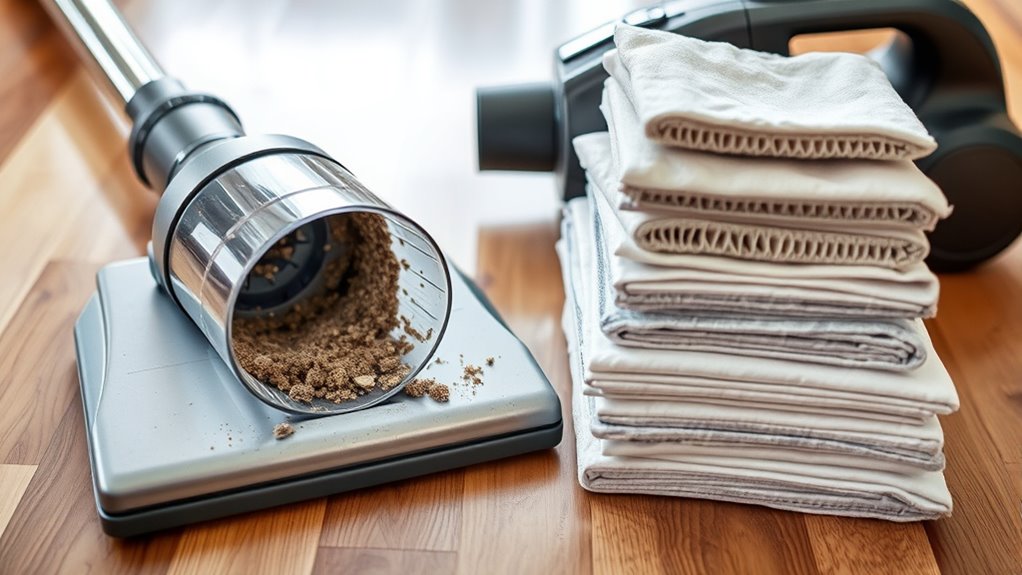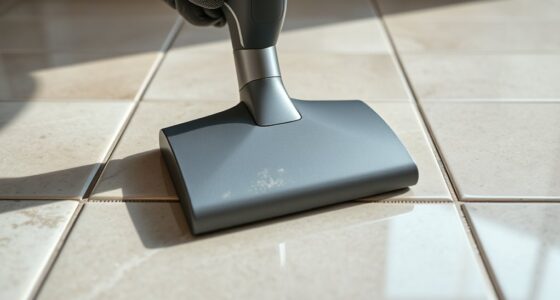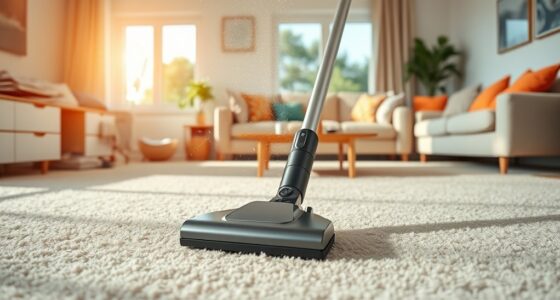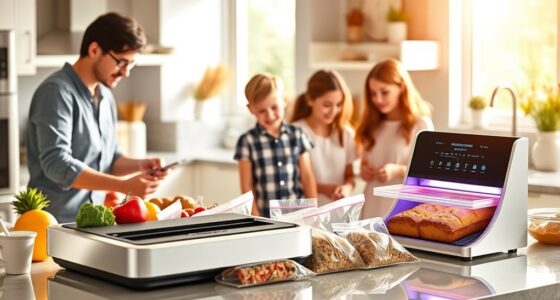To keep your vacuum cleaning effectively, replace bags when they’re about 75% full and change filters every 3 to 6 months, or sooner if they look dirty or discolored. HEPA filters may last longer but still need inspecting regularly. Regular maintenance prevents airflow issues, protects your motor, and keeps your indoor air quality high. Keep these tips in mind to ensure your vacuum performs at its best—more helpful details await if you continue.
Key Takeaways
- Replace vacuum bags when they are about 75% full or when dust begins to escape.
- Change filters every 3 to 6 months, or sooner if they appear dirty or discolored.
- HEPA filters may last longer but should be replaced when visibly dirty or after heavy use.
- Regularly check for decreased suction or airflow to determine if replacements are needed.
- More frequent replacements are necessary with pets, heavy cleaning, or high dust environments.
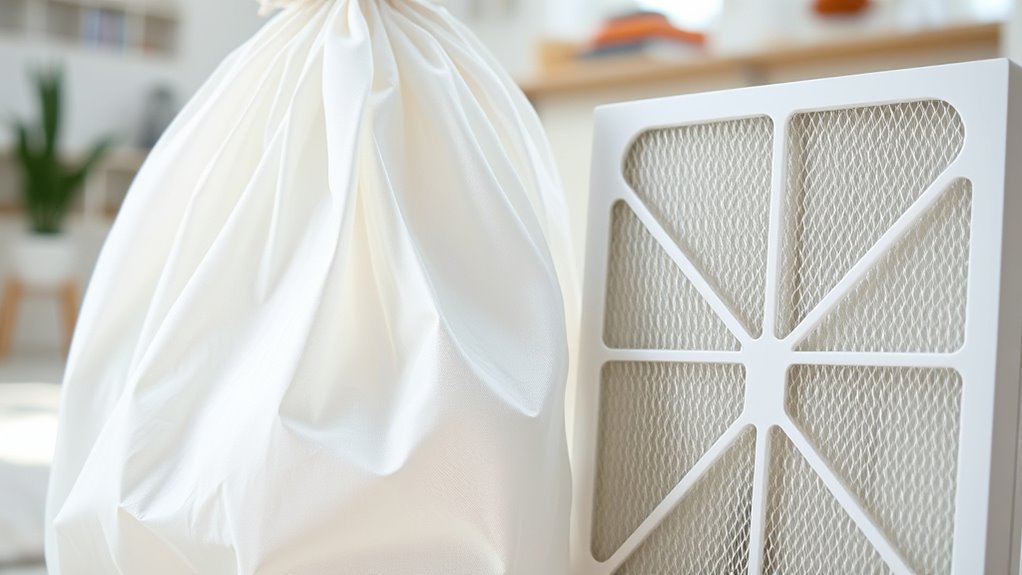
Regularly replacing your vacuum bags and filters is vital to maintaining peak cleaning performance. When you neglect this routine, dust buildup inside the bag and filter can markedly reduce your vacuum’s effectiveness. Over time, accumulated debris clogs airflow pathways, making it harder for your machine to pick up dirt and allergens. This not only diminishes cleaning power but can also strain the motor, leading to potential damage. To keep your vacuum operating at its best, it’s imperative to monitor how often you change these components and follow recommended guidelines.
Understanding how dust buildup impacts your vacuum’s performance is key. As dust accumulates in the bag or filter, airflow becomes restricted, forcing the motor to work harder. This increased workload can cause overheating and prematurely wear out parts, shortening the lifespan of your vacuum. Regularly replacing your vacuum bags prevents excessive dust buildup and guarantees maximum airflow. Similarly, changing filters at the right intervals helps maintain their effective filtration capabilities, which is especially important if you or anyone in your home suffers from allergies or respiratory issues. Additionally, proper maintenance can extend the overall lifespan of your vacuum and ensure optimal cleaning results.
Dust buildup restricts airflow, strains the motor, and shortens your vacuum’s lifespan. Regular replacement is essential.
The lifespan of filters varies depending on the type and usage, but a general rule of thumb is to replace them every three to six months. HEPA filters, for example, tend to last longer but still need replacement when they become visibly dirty or after a certain period. Keep an eye on your filter’s condition; if it appears clogged or discolored, it’s time for a change. Many vacuums have indicators or specific recommendations in the user manual to guide you on timing. If you use your vacuum frequently or have pets that shed hair and dander, you might need to replace filters more often to prevent dust buildup from compromising your cleaning.
Vacuum bags should be replaced when they are about 75% full. Waiting until they are completely full can cause dust to escape and clog filters, making your vacuum less effective. Regularly checking the bag’s fullness and replacing it promptly guarantees consistent suction power and prevents dust from escaping back into the air. If you notice a drop in suction or see dust escaping from the bag compartment, it’s a clear sign that it’s time for a new bag.
Frequently Asked Questions
Can Using Old Bags Harm My Vacuum’s Performance?
Using old bags can harm your vacuum’s performance by reducing suction power and straining the motor. As the vacuum bag lifespan approaches, debris gets clogged, making it harder for your vacuum to work efficiently. Regular filter replacement frequency is also vital; dirty filters restrict airflow and decrease cleaning effectiveness. To keep your vacuum running smoothly, replace bags when nearly full and change filters as recommended.
Are There Eco-Friendly Options for Replacement Bags and Filters?
You can find eco-friendly replacement bags and filters made from biodegradable materials, and some brands participate in recycling programs. While it might seem less durable, these options are designed to reduce environmental impact without sacrificing performance. You’d be surprised how many companies now prioritize sustainability, giving you a greener alternative. Switching to biodegradable or recyclable bags helps protect the environment and keeps your vacuum functioning efficiently.
How Do I Know if My Vacuum Filter Is Still Effective?
You can tell if your vacuum filter is still effective by checking its filter lifespan and performing effectiveness testing. If it’s been in use for a long time or looks dirty and clogged, it may be less efficient. Conduct a simple test by vacuuming a small area and inspecting the airflow and suction power. If you notice reduced performance or increased dust, it’s time to replace or clean the filter for peak efficiency.
Do Different Vacuum Models Require Different Replacement Schedules?
Like a trusted map guiding your journey, your vacuum model determines its own replacement schedule. Different vacuum models have unique needs, so you should follow the manufacturer’s recommendations for each. Check your user manual or label for specific intervals, and be attentive to signs of reduced performance. Customizing your replacement schedule guarantees your vacuum stays efficient, just as a well-tuned compass keeps you on course.
What Are the Signs of a Clogged or Full Vacuum Filter?
If your vacuum filter is clogged or full, you’ll notice a loss of suction and decreased cleaning power. You might also see dust or debris escaping from the filter area, or the vacuum may overheat. Filter clogging hampers airflow, making your vacuum less effective. To keep it running smoothly, check your filter regularly, especially if you see these signs, and replace it as recommended to restore peak suction and cleaning performance.
Conclusion
To keep your vacuum performing at its peak, replace bags and filters regularly—usually every 1 to 3 months, depending on usage. Neglecting this can turn your clean home into a dust disaster, risking your allergies and the vacuum’s lifespan. Think of it as giving your appliance a much-needed spa day; it’ll thank you with powerful, spotless performance. Stay proactive, and your vacuum will serve you better than a loyal butler in a mansion.
